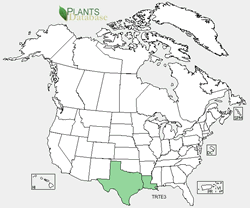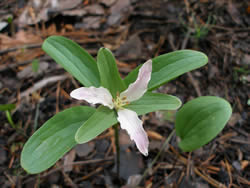Plant of the Week
 Trillium texanum range map. USDA PLANTS Database.
Trillium texanum range map. USDA PLANTS Database.
 Trillium texanum. Photo by Thomas C. Philipps.
Trillium texanum. Photo by Thomas C. Philipps.
 Trillium texanum. Caddo Parish. Louisiana Natural Heritage Program. Louisiana Department of Wildlife and Fisheries.
Trillium texanum. Caddo Parish. Louisiana Natural Heritage Program. Louisiana Department of Wildlife and Fisheries.
Texas Wakerobin (Trillium texanum)
By Thomas C. Philipps
All trillium species belong to the Liliaceae (lily) family and are rhizomatous herbs with unbranched stems. Trillium plants produce no true leaves or stems above ground. The “stem” is actually just an extension of the horizontal rhizome and produces tiny, scalelike leaves (cataphylls). The above-ground plant is technically a flowering scape, and the leaf-like structures are actually bracts subtending the flower. Despite their morphological origins, the bracts have external and internal structure similar to that of a leaf, function in photosynthesis, and most authors refer to them as leaves.
Trilliums are generally divided into two major groups, pedicellate and sessile trilliums. In the pedicillate trilliums, the flower sits upon a pedicel that extends from the whorl of bracts, and is either “erect” above the bracts or is “nodding” recurved under the bracts. In the sessile trilliums there is no pedicel and the flower appears to arise directly from the bracts.
Texas trillium (Trillium texanum) is known from Texas and adjacent Louisiana, thought it is lumped into the more widely dispersed variety pusillum in the recent Flora North America treatment. Texas trillium flowers from March to early mid-April and is typically found forested wetland habitats. It is a diminutive plant that flowers before full leaf-out of overstory species and before being overtopped by other herbaceous species. Interestingly, Texas trillium falls within the pedicillate group of trilliums, while another related variety (T. virginianum) does not. Although the taxonomy of the Trillium pusillum complex seems to be in need of further work, all entities within this group are considered to be of conservation concern and should be protected.
For More Information
- PLANTS Profile - Trillium texanum, Texas wakerobin
- Rare Plants of Louisiana - Texas Trillium (PDF)
- Case, F.W., R.B. Case. 1997. Trilliums, Timber Press, Portland, OR.

